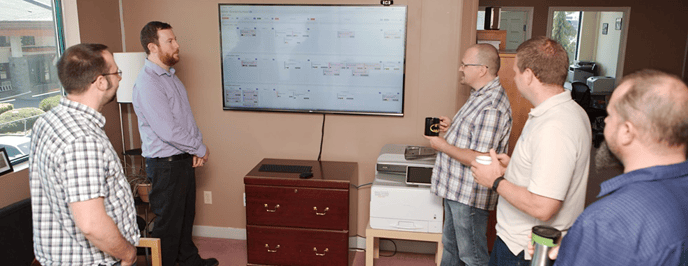Week 5: Begin a Daily Meeting

Time required: 1 hour for making decisions about the meeting; then 5 to 10 minutes per day
The team has spent a week using Kanban to manage the flow of work. Now begin a short daily meeting that keeps everyone up-to-date and improving the flow.
This doesn't need to be your team's only recurring meeting. You may have weekly and quarterly meetings too. But the daily meeting is the most important because it has the biggest impact on the day-to-day flow of work.

There are many ways to run a daily meeting. The method prescribed here is by no means the best or only way. Our method is based on what we've learned after trying a few different things and we think it will work well for your team too.
Make a few decisions:
- Time of day: Choose the earliest time in the morning that most team members are available most of the time. For example, 9 AM.
- Length: 10 minutes should be the maximum time scheduled. From time to time you might go longer, but this shouldn't be a regular occurrence. To encourage keeping the meeting short, everyone stands up. Topics requiring in-depth review between a few members should be discussed after the meeting.
- Attendees: Everyone working on the Kanban workflow should attend. If you have remote workers or regularly need members to attend while at home or on the road, ensure you have a good conference phone.
- Location: Choose a location where the team can all gather and see the Kanban board. We suggest using a large TV mounted on a wall. The location does not have chairs or a table, since you're standing.
- Leader: Any team member can lead the meeting. In fact, some teams rotate the leader every day. The leader's role is simply to ensure that the agenda is covered and attendees stay on topic.
- Agenda:
- Metrics- discuss key business metrics, such as number of urgent or neglected tickets or billable vs. non-billable hours
- What's blocked- review each ticket in a blocked status and identify ways to unblock them
- Today's activities- team members mention what tasks they are working on today
- Team updates- team members quickly mention out-of-the-ordinary work arrangements, such as leaving early, time out of the office for doctor's appointments, or upcoming days off
Do the meeting for three or four days and then review what parts are useful and what needs to be improved. Remember that every part can be changed, but sometimes it takes a few iterations to feel comfortable with a new method. Avoid making changes after just one meeting.
Post the agenda on the wall at the meeting location. This helps everyone stay on topic and allows any member to lead the meeting because the agenda doesn't need to be memorized.
Consider if a dedicated meeting board in TopLeft would make the meeting more effective. Some ideas are:
- Make a board that omits backlog and ready tickets, since these are not usually discussed in a daily meeting
- Use a swimlane. If you focus on tickets that are assigned to each member in turn, try a resource swimlane. If you focus on tickets by priority, use a priority swimlane.
- To easily identify old tickets, enable these options in the TopLeft board: show ticket age, status age, and time entries
Document the basics of the meeting (time, place, attendees, rough agenda) in the same place you document other organization processes.
As an example, when discussing BTR tickets in your meeting, focus on tickets that are blocked and discuss in the team how to unblock them. If a member has started a ticket but has been interrupted, the member should ask if other members are available to take it over and complete it.
Next up: Week 6
Further Reading
Much as been written on the topic of daily meetings. Here are a few useful resources:
![White logo TopLeft_240x78.png]](https://help.topleft.team/hs-fs/hubfs/White%20logo%20TopLeft_240x78.png?height=50&name=White%20logo%20TopLeft_240x78.png)